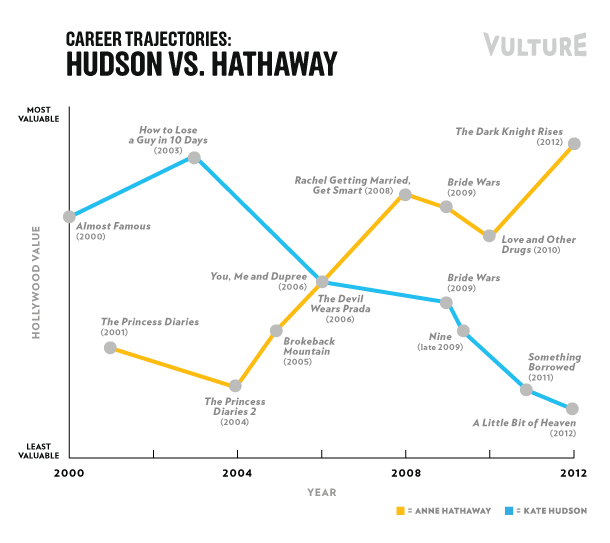
The year is 2003, the scene is any movie theater in America: Kate Hudson, the sunny, free-spirited star of Almost Famous and How to Lose a Guy in 10 Days, is the ruling rom-com queen, while Anne Hathaway is almost exclusively known as “the girl from The Princess Diaries.” Fast-forward six years to Bride Wars, in which Hudson and Hathaway meet, and oh, how things have changed: Hathaway’s star is rising, Hudson is in a rut, and their career trajectories are headed in opposite directions. By the time we arrive at 2012, the trade is complete: Hathaway ranks 61st on Vulture’s Most Valuable Stars List; Hudson does not rank at all. How to explain this total reversal of Hollywood fortune? Vulture now presents an in-depth analysis of the wildly divergent careers of Kate Hudson and Anne Hathaway, as a case study of the decisions, projects, and turns of luck required to succeed in Hollywood.
2000: With only a few teen movies (and one guest turn of Party of Five) under her belt, 21-year-old Kate Hudson catapults to the big time with her dreamy, druggy turn as Penny Lane in Cameron Crowe’s Almost Famous. She lands an Oscar nomination; she marries a (much older) rock star. Her cool cred is off the charts, and Hollywood is abuzz about her potential — funny and touching; pretty and relatable.
2001: Nineteen-year-old Anne Hathaway, a trained theater actress with a recurring role on the early Jesse Eisenberg vehicle Get Real, stars alongside Julie Andrews in the ugly-duckling teen fairy tale known as The Princess Diaries. The movie brings in a hefty $100 million and announces Hathaway as the New Hayley Mills (or Hilary Duff) — a Disney character made real, with a string of wholesome movies awaiting her.
2003: After Famous, Hudson makes a brief pit stop in the costume drama department (Sudanese war epic The Four Feathers, which co-starred Heath Ledger), but she quickly finds the genre that clicks — romantic comedy — and triples down. Rom-coms How to Lose a Guy in 10 Days, Alex and Emma and Le Divorce are all released in the same year, and though the latter two are instantly unmemorable (or memorably bad, in the case of Le Divorce), How to Lose a Guy is a box-office bonanza ($100 million domestically). It’s also in many ways the paradigm of the modern romantic comedy — An independent (but still girly) blonde! A magazine job! Martinis and pranks! — and Hudson shines; she makes the boilerplate banter and the meet-cutes look natural. Her bubbly, America’s Sweetheart reinvention is complete.
2004: Hathaway follows the cutesy Princess Diaries with a bit role in a limited-release Dickens adaptation (Nicholas Nickleby, 2002), but is far more prominent in two more fairy tales: Ella Enchanted (real-life Cinderella for the preteen set) and The Princess Diaries 2: Royal Engagement (Princess Diaries for people who want to see Anne Hathaway make out with Chris Pine next to a topiary). And offscreen, the wide, Disney Princess-eyed Hathaway hooks up with a hunky, aristocratic (or so he seemed) Italian boyfriend. At this point, it’s starting to look like high school students will soon be dressing up as Anne Hathaway and taking pictures with kids at Disney World for their summer job.
2005: Both actresses, firmly established in their respective genres, try to diversify. Hudson, fresh off the forgettable Raising Helen, signs up for bayou horror film The Skeleton Key; Hathaway, clearly desperate to shed the squeaky-clean Disney image, picks the edgy-ish teen film Havoc (half nudity, at least) and a supporting role in Brokeback Mountain. But the strategy here is different: Hudson goes the box-office route, attempting to segue her rom-com appeal into success in another moneymaking mainstream genre. Hathaway (who, it should be noted, trails Hudson in Oscar nominations at this point) makes a play for credibility — and it pays off. She’s swanning around in front of Oscar voters; Hudson is trapped in a so-so slasher movie. While she gets good reviews in it, the general reception to the film itself is so muffled with indifference that it doesn’t matter.
2006: In one corner, we have The Devil Wears Prada, an aspirational fashion-world romp; in the other is You, Me and Dupree, a doofy buddy comedy. Both are financial successes ($124 and $75 million*, respectively). Both feature our heroines as straight women, jockeying for a laugh when the more memorable actors (Streep! Wilson! Blunt! Dillon!) take a breath. For Hudson, Dupree is a demotion; she used to be a centerpiece, and now she’s stuck on the sidelines, huffing with annoyance at Owen Wilson’s slacker antics. But standing in Meryl Streep’s shadow is a step up for Hathaway; her role is the lead, and even if it is the less flashy part, she now shares a billing line and much screen time with the most respected actress in Hollywood. It’s a boost.
2008: Hathaway charms the masses with Get Smart and the critics with Rachel Getting Married, the indie that brings in her first Oscar nomination (and enables that entirely winning opening dance sequence with Hugh Jackman at the 2009 ceremony). The versatility is key here; after three years on the Princess circuit, Hathaway proves she can swing from (fictional) magazine flunky to Girl Friday to Serious Actress and back again. Meanwhile, Hudson retreats back to the safety of rom-coms, with diminishing returns: Fool’s Gold, which pairs her with How to Lose a Guy co-star and national treasure Matthew McConaughey, ekes out $70 million at the box office (a number she has not topped since) but gets trashed by critics. My Best Friend’s Girl is an all-around bust and stars Dane Cook. Compare his comedy-aesthete credibility to that of Get Smart’s Steve Carell: By this time, for all his mass popularity and arena sell-outs, Cook has become a snarling punch line for critics and comedy snobs who consider him the frat guy’s best friend, while Carell is well respected for The Office. Get Smart may be far from sophisticated, but Carell’s reputation makes it feel like it’s a step above. Hathaway has learned to surround herself with talent and credibility, a habit that Hudson will not pick up until it’s too late.
2009: As their star trajectories veer in opposite directions (Hathaway: up! Hudson: not up!), H & H’s careers finally meet in Bride Wars, a big-budget rom-com that pits our heroines against each other in a battle of BFF brides. For Hathaway, it’s just a lark, a fun girly movie to reinforce her range; for Hudson, it’s make-or-break, a chance to get out of the rom-com slump. That doesn’t work. The movie is savaged by critics and genre purists alike (though it grosses a respectable $58 million domestically). While a widely maligned movie is not ideal for either actress, it’s merely a blip on the radar for the ascendant Hathaway, who now has her pick of awards bait or blockbuster gigs. She’s proven she can handle both wrenching drama and action comedy — she has some Oscar capital to spend. But Hudson has only been making middling boy-meets-girl movies, and the failure of Bride Wars is part of a larger, damaging pattern. She seems to realize this in time for Nine — a clearly calculated attempt to get herself next to big, respected names — but unfortunately, the movie’s quality doesn’t live up to its pedigree. (As in, it’s really bad.) And while Hathaway gets the benefit of the doubt for a movie like Bride Wars, since she’s been seen doing other things, Hudson just seems out of her element in Nine. While the creative failure of the movie isn’t her fault, it subconsciously reflects on her in light of her slippage; she got her shot in classy material and it didn’t work. She can’t make the rom-com work, and she can’t branch out — it’s a tricky spot to be in.
2010: Hudson continues to belatedly diversify — this time with the violent Sundance thriller The Killer Inside Me, which gets a lot of press at the fest — but she’s overshadowed by Jessica Alba, who gets brutally beaten up in the movie’s buzziest scene. Hathaway, meanwhile, hops from Valentine’s Day (presumably a favor to Princess Diaries director Garry Marshall) to Tim Burton’s mind-bogglingly successful Alice in Wonderland to the “serious romance” (or is it a terminal illness movie? Who can tell!) Love and Other Drugs. This last project is a disappointment, in part because of its muddled plot but also because it’s sold as the Anne Hathaway Nudity Movie, and audiences don’t seem ready to accept Hathaway as a full-on sex symbol. (Catwoman will fix this come 2012, and without the nudity, too; that suit works like a charm.)
2011: Hudson’s Last Stand is pinned to Something Borrowed, in which the fallen Rom-Com Queen returns to her kingdom — but as the zany villain. We will say this for Hudson: She gives it her all and is by far the most enjoyable part of an otherwise bland, be-sweatered movie. But playing a different part in the same kind of movie does not count as diversification; people look at the trailer or poster, see her face connected to a romantic comedy, and roll their eyes, assuming it’s more of the same and not bothering to ponder the ramifications of this role switch. The movie sputters out, and the rom-com reign of Kate Hudson seems over.
2012: Hathaway is coming off a rocky stretch, following the iffy Love and Other Drugs with 2011’s forgettable One Day and a poorly received Oscars hosting gig. (That one was mostly James Franco’s fault, but remember: co-stars matter.) In any context, The Dark Knight Rises would be a major moment — the most anticipated film of the year and a chance to be sexy! — but given her 2010–11 track record, it’s a total coup. Her Catwoman steals every scene, and she’s almost certainly guaranteed a spinoff. And lest the Batcycle breakthrough peg her to the comic-book genre, she’ll wisely follow Dark Knight with a highly dramatic role in the Tom Hooper adaptation of Les Misérables — a movie so chock-full of feelings that even the trailer (which, notably, centers on Hathaway) can make you cry.
As for Kate Hudson, well, the ass-cancer rom-com Little Bit of Heaven did about as well as its slugline would suggest. (Straight to video, more or less.) She’s slated for a three-episode arc on Glee this fall — a gig that Hathaway was once rumored for, before Christopher Nolan and “I Dreamed a Dream” tied up her schedule for the foreseeable future — and The Reluctant Fundamentalist, Hudson’s attempt at serious, vaguely geopolitical drama, will premiere at Venice. She’s back at square one (or square Nine), trying to prove, genre by genre, that she can do more than tear through fashion closets and wink-wink her way to romantic happiness. In the meantime, Anne Hathaway is sitting pretty, waiting for that Catwoman script — and really, any other project that might strike her fancy. She does it all! So Hollywood seems ready to let her do anything.
* This post originally quoted the international gross of You Me and Dupree, which was $130 million. It earned $75 million domestically.





